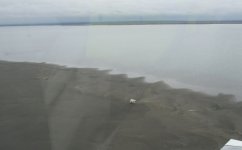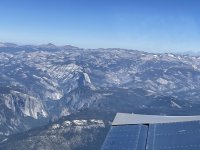Van's Air Force
You are using an out of date browser. It may not display this or other websites correctly.
You should upgrade or use an alternative browser.
You should upgrade or use an alternative browser.
RV-9A Grin!
- Thread starter RV9Walt
- Start date
PilotjohnS
Well Known Member
Great plane. Take the time to really get to know the plane, and tweak it to meet your needs.
Here is from my 4 hour flight back from oregon.
Hope you can figure out where it is.
I agree with what John is saying. The 9A is a very straight forward airplane - no surprises. I did some stall practice today - down to 46k, buffet, then slight drop in left wing. Recover in about 100 feet. Then on the way back to the airport I was in cruise mode at 150k. They are quite a bit slicker than a Cessna so you do have to think about what you are doing when you want to land but go-arounds are just plain fun!
What a fun place. We used to ride our bikes from Placerville to Yosemite. Did the John Muir Trail from Tahoe to Whitney one year. Beautiful.
Dugaru
Well Known Member
You’re going to love it
It just has no bad habits and is super easy to fly. And yes I’m biased.
It just has no bad habits and is super easy to fly. And yes I’m biased.
I flew my RV9A today for the first time, yes I bought it from a friend who built it. I did training with Mike Seager to transition to this from a Cessna 182, WOW everything he taught was spot on as was my flying because of it! Fly at speed it's perfect.
Walt
MacCool
Well Known Member
I agree with what John is saying. The 9A is a very straight forward airplane - no surprises. I did some stall practice today - down to 46k, buffet, then slight drop in left wing. Recover in about 100 feet. Then on the way back to the airport I was in cruise mode at 150k. They are quite a bit slicker than a Cessna so you do have to think about what you are doing when you want to land but go-arounds are just plain fun!
What a fun place. We used to ride our bikes from Placerville to Yosemite. Did the John Muir Trail from Tahoe to Whitney one year. Beautiful.
My transition CFI had owned an RV-6A with fixed-pitch prop. He initially warned me about how slick this RV-9A would be and that it would require some pre-planning in order to get it down to appropriate speeds in the pattern. So initially, I slowed it down and was dragging that thing in from 10 miles out. It was boring. I have since found that with its constant speed prop, I can enter the pattern at pattern altitude and only then throttle back to 15/2300. I'll be at approach speed as I turn base even if I'm doing an overhead break. The CS prop makes all the difference relative to speed management in the pattern.
Otherwise, I agree. The RV-9A does exactly what you tell it to do...no more, no less. Very responsive but completely predictable, no surprises. Stalls are a non-event. If you flare a little high in the landing, you can just keep pulling back on the stick. It's a great airplane and a blast to fly.
Dugaru
Well Known Member
Slowing down
I have a CS prop and also have zero problems slowing down in the pattern. Which is good because the flap extension speed on the -9 is relatively low (the airplane’s only real quirk, IMHO, and it’s pretty minor).
Actually, having done a few no-flap landings for practice, I’m beginning to think a 9 with a constant speed prop could do without flaps entirely, like a Cessna 120. No-flap landings in the 9 are a total non-event handling-wise, and the effect on landing distance doesn’t appear to be massive. Obviously with flaps installed it’s better to use them, but I really don’t think they’d be missed all that much if the plane didn’t have them.
No-flap landings in the 9 are a total non-event handling-wise, and the effect on landing distance doesn’t appear to be massive. Obviously with flaps installed it’s better to use them, but I really don’t think they’d be missed all that much if the plane didn’t have them.
I have a CS prop and also have zero problems slowing down in the pattern. Which is good because the flap extension speed on the -9 is relatively low (the airplane’s only real quirk, IMHO, and it’s pretty minor).
Actually, having done a few no-flap landings for practice, I’m beginning to think a 9 with a constant speed prop could do without flaps entirely, like a Cessna 120.
My transition CFI had owned an RV-6A with fixed-pitch prop. He initially warned me about how slick this RV-9A would be and that it would require some pre-planning in order to get it down to appropriate speeds in the pattern. So initially, I slowed it down and was dragging that thing in from 10 miles out. It was boring. I have since found that with its constant speed prop, I can enter the pattern at pattern altitude and only then throttle back to 15/2300. I'll be at approach speed as I turn base even if I'm doing an overhead break. The CS prop makes all the difference relative to speed management in the pattern.
MacCool
Well Known Member
I have a CS prop and also have zero problems slowing down in the pattern. Which is good because the flap extension speed on the -9 is relatively low (the airplane’s only real quirk, IMHO, and it’s pretty minor).
Actually, having done a few no-flap landings for practice, I’m beginning to think a 9 with a constant speed prop could do without flaps entirely, like a Cessna 120.No-flap landings in the 9 are a total non-event handling-wise, and the effect on landing distance doesn’t appear to be massive. Obviously with flaps installed it’s better to use them, but I really don’t think they’d be missed all that much if the plane didn’t have them.
I'm just the opposite. Especially at my home airport (big runways), I use flaps on landing mostly for practice....usually don't use them.
What's your flap extension speed? My POH says that I can start flap deployment at 90 kts.
MacCool
Well Known Member
No flaps, I'm usually over the fence at 65 knots. Full flaps, 60 knots.
My speed and flap decisions usually depend on the runway and wind. On two of the runways at home, it's rare that I can't make the first turn-off. From the other directions, I either have to fly more than a mile down the runway, or have a very long taxi.
I practice short/soft field landings, but it would be pretty rare for me to land at an airport that would require them.
My speed and flap decisions usually depend on the runway and wind. On two of the runways at home, it's rare that I can't make the first turn-off. From the other directions, I either have to fly more than a mile down the runway, or have a very long taxi.
I practice short/soft field landings, but it would be pretty rare for me to land at an airport that would require them.
Dugaru
Well Known Member
My numbers
I also do 60 knots over the fence with flaps, 65 with no flaps.
I start feeding flaps in around 80 knots, just to be on the safe side, since I figure I can't really tell the difference between 15 and 32 degrees. Perhaps I should mark them with hash marks like on a Boeing. Come to think of it, that might be a good idea!
Come to think of it, that might be a good idea!
I also do 60 knots over the fence with flaps, 65 with no flaps.
I start feeding flaps in around 80 knots, just to be on the safe side, since I figure I can't really tell the difference between 15 and 32 degrees. Perhaps I should mark them with hash marks like on a Boeing.
No flaps, I'm usually over the fence at 65 knots. Full flaps, 60 knots.
My speed and flap decisions usually depend on the runway and wind. On two of the runways at home, it's rare that I can't make the first turn-off. From the other directions, I either have to fly more than a mile down the runway, or have a very long taxi.
I practice short/soft field landings, but it would be pretty rare for me to land at an airport that would require them.
MacCool
Well Known Member
So for the -9/9As, the flap limit speeds are 100 MPH/87 Kts up to 15 degrees, and 90 MPH/78 Kts to full flaps (32 degrees).
Yeah, this was kind of a problem for me when I was calibrating my (AFS AoA). I needed to fly a zero-G parabola with both no-flaps and full flaps. With full flaps, it was hard for me to do without overspeeding them.







